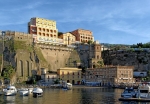Information about Sorrento
Sorrento is an Italian municipality located in the Metropolitan City of Naples, Campania region. It has 16,745 inhabitants.
It was an archiepiscopal seat from the year 420. After the fall of the Western Roman Empire, it was dominated by the Ostrogoths forming part of the Eastern Roman Empire. In 552 it passed into the hands of the Byzantines. The Lombards, who conquered much of southern Italy in the second half of the sixth century, besieged it in vain. As in the following centuries the authority of distant Byzantium declined, Sorrento, from the 9th century, was an autonomous duchy, fighting with the neighboring cities of Amalfi, Salerno and against the Saracens.
In 1133 it was conquered by the Norman Roger II of Hauteville. In 1337 the Duchy of Sorrento was incorporated into the Norman kingdom, and Sorrento's history was henceforth linked, like Naples and other cities of Campania, to the newly created Kingdom of Sicily.
The historic center of the city still shows the orthogonal layout of the streets of Roman origin, while towards the mountain, it is surrounded by walls from the 12th century. There is the Duomo, rebuilt in the 15th century, with a neo-Gothic façade, and the church of San Francisco de Asís, with a notable 14th-century fresco. The Museo Correale exhibits collections of Greek and Roman finds and Neapolitan porcelain from Capodimonte, with a painting section from the 17th-19th centuries. From its gardens, you can also enjoy a magnificent view of the gulf.
Sorrento's name derives from the sirens, sea creatures with the head (sometimes also the torso) of a woman and the body of a fish. According to Greek mythology, they lived on a rocky island and tempted sailors with their beautiful songs, so that they shipwrecked on their coast and thus be able to devour them; Odysseus being the only one who could avoid them, according to Homer's Odyssey. Legends indicate a close connection between Lipari and Surrentum, colony of that in the past; and even during the Roman Empire Surrentum remained largely Greek. Before the Roman supremacy, it was one of the cities subjected to Nuceria, and they shared its fate in the Social War. It was controlled by the Romans in the year 89 a. C., but later both cities were allied in the revolt of 90 as Estabia; and was subjugated in the following years.
Its prosperity dates back to the imperial period, when Capreae was the favorite residence of Augustus and Tiberius. Numerous sepulchral inscriptions of imperial slaves and free men have been found at Surrentum. An inscription shows that Tito in the year after the earthquake of 79 restored the horology of the city and its architectural decoration. A similar restoration of an unknown building in Naples in the same year is recorded in an inscription from Surrentum.
The most important temples in Surrentum were those of Athena and that of the Sirens (the only one dedicated to them, in historical times, in the Greek world); and gave his name to the promontory. In ancient times, Surrentum was famous for its wines, its fishing, and its Campanian red-figure vases. The discovery here of coins from Massalia, Gaul and the Balearic Islands indicates a great commercial activity.



